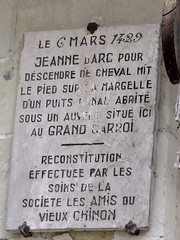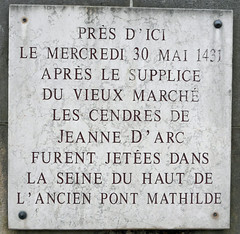Porte Saint-Honoré. Ouverte en 1380 dans l'enceinte de Charles V, la seconde porte Saint-Honoré formait un carré d'un étage flanqué à chaque angle par une tour ronde. Jeanne d'Arc y tenta une offensive, le 8 septembre 1429, pour reprendre Paris aux Anglais. Mais elle eut la cuisse percée d'une flèche, alors qu'elle sondait le fossé rempli d'eau pour le faire combler avec des fagots. Le 19 janvier 1591, Henri IV envoya des soldats déguisés en meuniers se faire ouvrir la porte sous prétexte de ravitailler les Parisiens assiégés : la "journée des farines" fut un échec, les Ligueurs avaient muré la porte. Après l'achèvement de l'enceinte dite de Louis XIII ou des Fossés Jaunes, la porte Saint-Honoré, devenue inutile, fut démolie en 1636.
163 Rue Saint Honoré, Paris
Google Streetview
OpenStreetMap
See also...
.jpg?width=250)
Tangopaso on Wikimedia Commons
CC-PD-Mark

Tangopaso on Wikimedia Commons
CC-PD-Mark







_plaque_jeanne-d'Arc.jpg?width=250)
.jpg?width=250)




